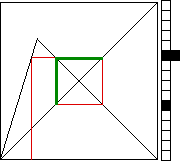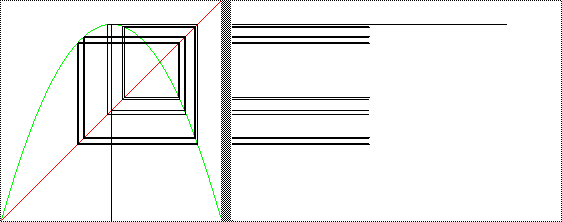Deterministic Chaos
6.D.3. Histograms of Orbits
Following the graphical iteration
path, we see some
of the paths appear to run over the same lines. Often, this is the effect of the nonzero
width of pixels. Near enough numerical values can fall in the same pixel.
To keep track
of this, we plot the histogram of the iterates.
Divide the
vertical unit interval into some number of bins, one bin per pixel.
Then every time an xi lands in a bin, we increment the counter of the number of points that have
landed in that bin.
Visually, we represent this by plotting another pixel to the right.

|
| Click the picture to see the first few steps in constructing
a histogram. |
Here are some examples for the
logistic map L(x) = s*x*(1 - x). The
vertical gray band
separates the graphical iteration plot from the
histogram.
|
|
 |
| s = 3.566 What's this? Taking into account the interpretation of thick lines as
nearby points in the cycle, this might appear to be a 15-cycle: five horizontal lines two pixels thick, five
horizontal lines one pixel thick. However, the top line is twice as long as the others, and corresponds to
two distinct points of the orbit, so close they occupy the same pixel in the histogram. Each time the orbit
visits either of these points, the one pixel is added to the corresponding horizontal line of pixels. That is,
this line of pixels grows twice as quickly as the others. So we are looking at the histogram of a 16-cycle. |
|
Return to Deterministic Chaos.

